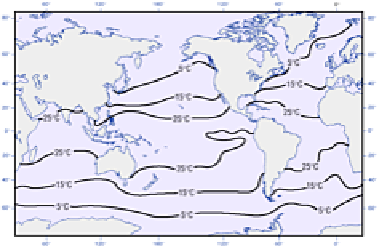Environmental Engineering Reference
In-Depth Information
Figure 1
Ocean surface temperature.
Source: Adapted from Summerhayes and Thorpe (1996).
Tectonic processes are not modelled in AOGCMs but they, too, influence ocean
circulation and its climatic impact by transforming ocean geometry. We can speculate on
the pre-Cenozoic climatic character of land bordering the Atlantic when it was too
narrow to support major ocean gyres, including the Gulf Stream, or the effects of the
equatorial current between the Americas before late Cenozoic closure of the Panama
seaway. Similarly, the mid-Cenozoic opening of the Drake Passage between South
America and the Antarctic Peninsula
c
. 40 Ma ago connected up the Antarctic
circumpolar current. By isolating the southern ocean and emphasizing the Antarctic
convergence, it probably triggered the development of the Antarctic ice sheet.
OCEAN CIRCULATION
Fluid properties shared by atmosphere and ocean permit the development of thermally
driven near-surface circulatory systems, comprising ribbons of air or water currents
moving around seasonally mobile cells (atmosphere) or
gyres
(ocean). The apparently
stable character of the oceans is indicative of thorough surface mixing. Ocean motion
occurs in two other, non-circulatory forms. Shallow, transient
wave
motion is generated
by air flow at the ocean-atmosphere boundary layer and may superficially mimic larger
current systems.
Tides
form an oscillatory response to gravitational mass attractions
between Earth, sun and moon.
Ocean-atmosphere coupling of water, heat and momentum transfers is also influenced
by Earth's rotation. Thus we may model similar, simple overturning cells of tropically
heated water moving poleward, cooling and
downwelling
(subsiding) to form lower
return currents which
upwell
(ascend) at the equator. The Coriolis force (see Chapter 6)
draws water to the right of its path in the northern hemisphere and to the left south of the
equator. As in the atmosphere, there are areas of divergence and convergence. Broad
similarities end there. Oceans are capable of sustaining internal heat and motion for far
longer, by virtue of their higher specific heat capacity and slower-moving mass, but basin
geometry restricts circulation more than continental relief influences the atmosphere.





